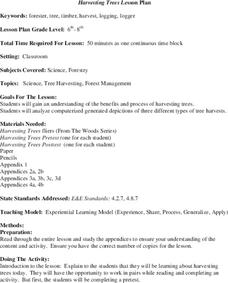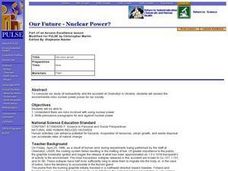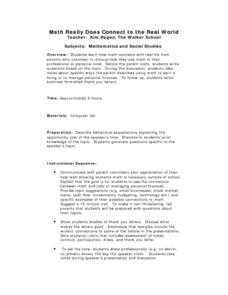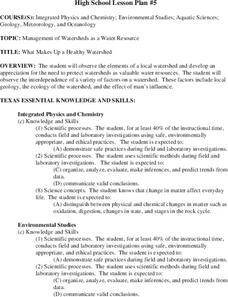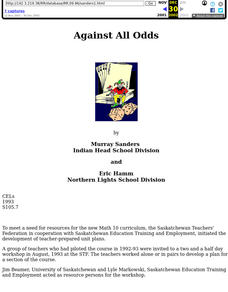Curated OER
Harvesting Trees
Students examine and discuss benefits and process of harvesting trees, analyze, compare, and contrast computer-generated depictions of three different types of tree harvesting methods, read Harvesting Trees flier, and answer discussion...
Curated OER
DNA, Genes, and Chromosomes
Students review the structure and function of DNA, genes, and chromosomes and are engaged by a demonstration illustrating the relative size of DNA, genes and chromosomes. They also describe through analogy and model the structure and...
Curated OER
Our Future - Nuclear Power?
Students comprehend that there are risks involved with using nuclear power. They write persuasive paragraphs for and against nuclear power. Students analyze the environmental issues and risks with nuclear power.
Curated OER
You Kiss the Book: Shakespeare's Romeo and Juliet
Students analyze imagery in Shakespeare's, Romeo and Juliet, and act out the passage to see how the author includes stage directions with his poetry.
Curated OER
Plant Classification
Students participate in an experiment that involves plant classification. They identify and are able to employ three methods of classifying leaves. Each student classifies leaves by each of the following methods: K-I 4.b, d, & e;...
Curated OER
Acceptance Sampling
In this algebra activity, students sample food and identify acceptance sampling. They create specific plans to meet specific situations as they sample the food. There are 6 questions.
Curated OER
Telling a Story
Students create a story about a picture. In this writing lesson, students select a picture and write a story about what happened in the picture. Students are encouraged to write a story with a beginning, middle, and end.
Curated OER
History of Blood Transfusions
Eighth graders use the Internet to research the important people in history of blood transfusions. In this blood transfusions lesson students prepare and present an oral presentation of their research.
Curated OER
Hand Sensitivity
Students experiment with the sense of touch. In this tactile lesson, students determine the most sensitive area of the hand. Students experiment by describing objects through touch only. Students compare the amount of sensory data...
Curated OER
Congruent Shapes
In this geometry lesson, students trace the capital letter "T" in different directions to learn how a shape is congruent. Students trace this letter on a sheet of paper, then turn, flip it, and trace it in different
directions, only to...
Curated OER
Math Really Does Connect to the Real World
Students listen to parent speakers who discuss how they use math in their professional or personal lives. They take notes and write business form thank you letters.
Curated OER
What Makes Up a Healthy Watershed
Students, after observing the elements of a local watershed, explore the need to protect watersheds as water resources for the future. They examine the factors involved with a watershed: geology, ecology, and the effect of man's...
Curated OER
Tableau
Second graders view a video from United Streaming and design still frames of important parts of a story. In this story-telling from different cultures lesson plan, 2nd graders understand general vocabulary about performing. Students...
Curated OER
Wood You Believe: Wood Products
For this wood products lesson, students walk to a forest near their school where they sit by themselves for a few minutes and quietly observe their surroundings. Students brainstorm wood or wood by products, discuss everything we get...
Curated OER
Defining Issues
Students work on a 'campaign committee' to define civic issues that are important to them and their community. They write letters to city officials with proposals for how to address these issues.
Curated OER
My Secret War: The WWII Diary of Madeline Beck: Lesson 11
Fifth graders explore world history by participating in a class game. In this propaganda lesson plan, 5th graders identify Madeline Beck and the role women played during World War II. Students create fictitious propaganda posters and...
Curated OER
Guetemala's Changing Forest
Eighth graders compare their local ecological zone to the tropical rainforest. In this natural ecology lesson, 8th graders complete an activity about the differences in ecological zones. They compare their biome to the Guatemalan...
Curated OER
Toothpicks and Timber
Students problem-solve how to log five acres. Working in pairs, they construct models of logging sites before and after the trees are harvested. they paint their models and include other environmental details.
Curated OER
Tall Tales: Reconstructing A Personal Tell
Sixth graders discover the ways archaeologists examine artifacts and where they are found. After being introduced to new vocabulary, they use artifacts from their own lives and discover what could be told about their life from them. ...
Curated OER
Birds of Wisconsin
First graders explore the job done by ornithologists. They role play identifying the characteristics that make a bird a bird. They discuss what makes each bird species unique. Students are introduced to Wisconsin's most common and rare...
Curated OER
Against all Odds
Tenth graders appreciate the role of probability in understanding everyday situations. They Communicate a summary of financial projections in appropriate reports, tables, and graphs after creating a new game of chance.
Curated OER
Molecular Evolution in Plants
Students examine chlorophylls. They explore the absorbing pigments in a variety of plants. Through activities, students determine spectrophotometrically. They compare plant proteins from the family Brassicace to assess the level of...
Curated OER
Shark Attack
Students examine the white shark. They think critically about a set of shark facts and predict whether the statements are true or false. Students describe a year in the life of a white shark living in the Red Triangle. They create a...
Curated OER
What's It All About?- Kansas Prairies
Students examine the interdependence of animal life and the environment. In this Kansas prairies lesson, students read background information on prairies and complete a worksheet to identify the main idea.


